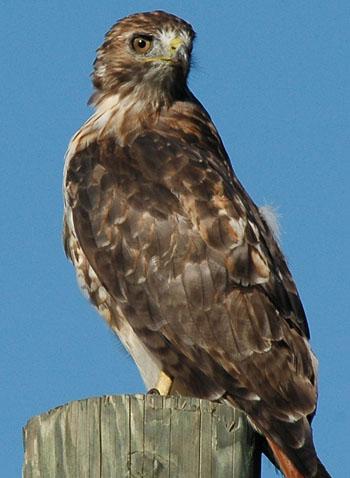Highway Hawks

Red-tailed hawk
Photo credit: Jim Williams
by Val Cunningham
Contributing Writer
Freeways are corridor cafes for red-tailed hawks as they perch patiently and wait for a roadside meal.
One of most spectacular hawks in our region is on the job every day, hiding in plain sight. Red-tailed hawks hunt metro-area freeways for food by perching on light poles, then swooping in for a kill. However, they mostly go unseen, since drivers can’t watch for them without endangering themselves or others. On some routes, notably Hwy. 36 in Ramsey County, the hawks are so plentiful and so evenly spaced that there seems to be one every mile.
All you might notice as you speed beneath a light tower is a hunched, oval shape. About two-thirds the size of a bald eagle, red-tails aren’t easily confused with other highway perchers, such as crows and pigeons.
Red-tails are the superlative raptor: the largest hawk in our area, the best known of the hawks and, some feel, the most beautiful. They’re also the easiest to recognize: If you see a large hawk with a red-tail, it’s a red-tailed hawk. However, it’s not always that easy, but more about that later.
Why are red-tails watching the traffic whiz by? Turns out they couldn’t care less about the vehicles nor are they waiting for roadkill. But they are fervently hoping for a rodent to emerge in the ditches alongside the highway. This perch-and-peer style saves a lot of energy, compared to flying over fields keeping an eye out for scuttling mice, voles, rats, cottontail rabbits and the occasional squirrel.
Freeway hunting can be hazardous to hawk health, as noted by the Raptor Center, which suspects vehicle collisions are the most common cause of injury to the red-tails it admits to its clinic. In warmer seasons red-tails can be seen perching in trees on golf courses, marshes, large parks and even backyards watching for prey.
For sheer beauty and power, almost nothing can beat the sight of a red-tail soaring and slowly turning circles over a field, marsh or roadway. From underneath it’s easy to see the hawk’s white belly, streaky chest band and stunningly red tail. Things get a little tricky if it’s a young bird, since these don’t develop the telltale tail color until they’re two years old.
This raptor’s distinctive hunting call is a loud, drawn-out “keee-aaaarrr,” sounding like a steam whistle to some people. You’ve probably heard the red-tail call in movies set in the West, since Hollywood directors seem to think this is how all hawks and eagles sound. (Red-tails do have a satisfyingly ‘big boy” call, as compared to the bald eagle’s much-less-impressive, high-pitched screech.)
When it comes time to build or refurbish their big stick nests in the springtime, a pair of red-tails often chooses a site in a tall tree overlooking an open field. Some of these nests, much smaller than bald eagle structures, can be visible from freeways. Sometimes the bird sitting patiently on a red-tail nest has a big round head with ear tufts on top—great-horned owls often usurp these nests to raise their own offspring.
If you want to catch this freeway phenomenon, it’s best to have a designated driver. Then you can give all your attention to light poles on Highways 62, 36, 35E, 100 and 494. Those big, dark shapes on top of the light towers are patient red-tails, settling in for a day of watching and waiting.
Hear the hawk
Hear the red-tails’ distinctive call here, the Cornell Lab of Ornithology’s All About Birds site with recordings by the spectacular Macaulay Library of Sounds.
Pale Male
The most famous red-tail in the world is still going strong in New York City. Pale Male, a very light-colored hawk, and his mate again raised a brood on top of a tall building across from Central Park in 2010. He and a mate have nested in the city beginning in 1995, attracting attention from around the globe for this unusual habitat choice. Pale Male is featured on web pages, in documentaries and in books; check out the PBS website to learn more about this amazing bird.
St. Paul, Minnesota resident Val Cunningham, leads bird hikes for the St. Paul Audubon Society and writes about nature for local, regional and national newspapers and magazines.



